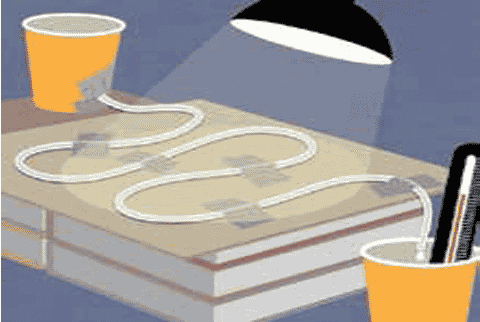Overview
STEM careers
Time
Materials
Per Small Group:
- Aluminum foil
- Large sheet of cardboard (11″ x 17″)
- Sunlight (alternative as needed: gooseneck lamp with an indoor 100-watt floodlight light bulb)
- Black paper
- Black marker (permanent, for coloring the plastic tubing)
- 2 paper cups (medium size)
- 3 feet (0.9 m) clear plastic tubing (outside diameter: 1⁄4″ or 6 mm)
- Pitcher of water
- Ruler
- Scissors
- Straws
- Duct tape
- Indoor-outdoor digital thermometer that can read tenths of a degree
- Paper and pencil for taking notes
Instructions
Students design and build a solar hot water heater and see how big a temperature change they can get; they then evaluate and redesign their heater to see if they can increase the temperature.
- Instruct students to construct their water-flow system as follows:

- Poke a small hole near the bottom of one of the cups and put the tube into the hole.
- Set a second cup under the tube’s other end.
- Test your system with water. Seal any leaks with duct tape.
- Empty any water from the system.
- Next, tell students to build their hot water heater. They should consider how best to use the materials available to design a system that can help the water absorb a lot of heat energy. Prompt students to consider ways to make the water absorb energy.
- When students are finished with their heater, tell them to put it in strong sunlight or 8 inches below the lamp. (Important: Keep water away from outlet, lamp, and bulb.)
- Instruct students to measure and record the temperature of the water in the pitcher.

- Pour water from the pitcher into the first cup.
- Record the temperature of the water as it comes out of the lower end of the tube.
- Discuss the results, as well as ways to get the system to absorb more heat.
- As time allows, students may redesign and retest to see how hot their solar heater can ultimately get the water.
Guiding questions
-
How can you use color to help your system absorb the most heat?
-
How fast do you want water to flow through the tube?
-
How can you slow down the water flowing through the tube?
-
What parts of the system can you improve to make it absorb more heat? The tube? The surface under the tube?
-
How could you redesign your water heater to make an even bigger temperature change than you got on your first try?
-
How could this type of system be used in a residential application?
Engineering & science connections
- The sun puts out an incredible amount of energy every day. When people think of solar energy, it is often photovoltaic technology for converting light into electricity. This activity involves a different kind of solar energy, called passive solar heating: the heat from the sun (or a light bulb) is transferred to heat in the water.
- Engineers design passive solar systems for homes to heat water for sinks, showers, and even swimming pools. Collector panels, which contain dark-painted tubes filled with water, are heated by the sun, and then circulate that hot water to a storage tank. Passive solar systems conserve use of electricity or natural gas, which are the conventional sources of energy for heating water.
- Passive solar building design uses windows, walls, floors, and ventilation to collect, store, and distribute solar energy in the form of heat in the winter and reject excess solar heat in the summer. Using passive solar building design, engineers can reduce energy needs for heating and cooling a building by 60% or more.
Activity adapted from Design Squad Nation. DESIGN SQUAD NATION is produced by WGBH Boston. Major funding is provided by the National Science Foundation. Project funding is provided by Northrop Grumman Foundation and S.D. Bechtel, Jr. Foundation. Additional funding is provided by United Engineering Foundation (ASCE, ASME, AIChE, IEEE, AIME).
This DESIGN SQUAD NATION material is based upon work supported by the National Science Foundation under Grant No. EEC-1129342. Any opinions, findings, and conclusions or recommendations expressed in this material are those of the author(s) and do not necessarily reflect the views of the National Science Foundation. © 2012 WGBH Educational Foundation. DESIGN SQUAD and DESIGN SQUAD NATION are trademarks or registered trademarks of WGBH Educational Foundation. All rights reserved.


0 Comments